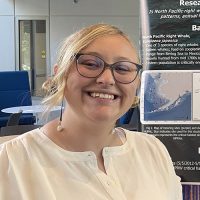
Sophia Wagner
Haverford College
Research Mentor: Catherine Berchok
Project: Factors influencing North Pacific right whale calling behavior
This summer I worked in the passive acoustics group in the marine mammal lab at the NOAA Alaska Fisheries Center in Seattle. My advisors, Catherine Berchok, Jessica Crance, and Eric Braen gave me the opportunity to create my own research topic about any marine mammal that they had sufficient recording data present from their recorders placed throughout coastal Alaska. I decided to focus my research efforts on the critically endangered U.S. subpopulation of North Pacific right whales. North Pacific right whales were hunted from the 1830s up into the 1960s for their fatty oils. Today, there are estimated to be roughly 30 North Pacific right whales left in U.S. water and 330 total left in the world. For my research, I decided to examine if their calling behavior is affected by diel patterns (day, dusk, night, dawn), light seasonality (in Alaska since it is so far north, there is a period of the year where there is no night), and anthropogenic vessel noise. These questions are important in understanding more about the elusive whales behavior for conservation purposes, but also in understanding the optimal ways in surveying them as scientists since NOAA scientists take in piggyback cruises searching for the animals. To analyze the calling behaviors, I worked in the computer software called  Raven to quantify and analyze the different call types associated with North Pacific right whales: gunshots and upcalls. Gunshot call bouts associated with songs are theorized by scientists to be a reproductive display while upcalls are theorized to be a contact call.
Raven to quantify and analyze the different call types associated with North Pacific right whales: gunshots and upcalls. Gunshot call bouts associated with songs are theorized by scientists to be a reproductive display while upcalls are theorized to be a contact call.
Overall, I analyzed over 2,000 minutes of recordings and extrapolated my data in RStudio. Some results that I found were that the highest gunshot calling activity was at night and the highest upcall calling activity was at dusk. This is useful, because it lets scientists know they should deploy temporary recording devices at night for a higher chance of hearing and/or seeing the whales. Another finding was that the North Pacific right whales tended to have the highest calling activity from July to December, the season when night time increases. Finally, I was able to look at the effect that vessel noise had on calling. It was found that the highest number of North Pacific right whale calls occurred in recordings where no vessel noise was present. This could be because they are calling more, or because we, and likely other whales, cannot hear their calls. This phenomenon is known as auditory masking. Further studies would have to be done to confirm exactly what is happening to these elusive whales. I had a lovely time working with my advisors and the rest of the marine mammal lab and learning a bit more about what happens behind the scenes at NOAA and listening to all sorts of fascinating and odd marine mammal noises!

